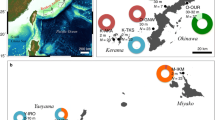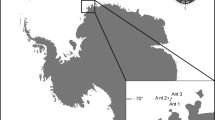Abstract
Allozyme electrophoresis at five loci was used to clarify the species status of two morphs of the scleractinian coral Montipora digitata (Dana, 1846), using specimens collected from three locations off the Queensland coast between October 1991 and April 1993. The two morphs, occurring sympatrically, were distinguished by one fixed gene difference at Locus LT-2 and frequency differences at three other loci, indicating reproductive isolation between them. Populations of both morphs were generally in Hardy-Weinberg equilibrium, suggesting that sexual reproduction does occur. Despite sampling designed to reduce the chance of collecting clonemates, the genetic diversity ratio (G O:GE) indicated that asexual reproduction also occurs. This is in agreement with the known modes of reproduction for this species. There was significant genetic differentiation between populations of one of the morphs of M. digitata. This could have been influenced by greater degrees of asexual reproduction in this morph, selection within sites, or variation in larval survival and recruitment patterns. Relatively low F st (differentiation among populations) values found for a broadcast spawning species during this study are in accordance with the hypothesis that brooded planulae are adapted for rapid settlement, whereas planulae produced by broadcast spawners are adapted for widespread dispersal.
Similar content being viewed by others
References
Ayre, D. J. (1984). The effects of sexual and asexual reproduction on geographic variation in the sea anemone Actinia tenebrosa. Oecologia 62: 222–229
Ayre, D. J., Read, J., Wishart, J. (1991 a). Genetic subdivision within the eastern Australian population of the sea anemone Actinia tenebrosa. Mar. Biol. 109: 379–390
Ayre, D. J., Veron, J. E. N., Dufty, S. L. (1991 b). The corals Acropora palifera and Acropora cuneata are genetically and ecologically distinct. Coral Reefs 10: 13–18
Ayre, D. J., Willis, B. L. (1988). Population structure in the coral Pavona cactus: clonal genotypes show little phenotypic plasticity. Mar. Biol. 99: 495–505
Belbin, L. (1987). PATN pattern analysis package. Reference manual. Part 1. CSIRO Division of Wildlife and Rangelands Research, Melbourne
Benzie, J. A. H. (1990). Techniques for the electrophoresis of crown-of-thorns starfish (Acanthaster planci) enzymes. Australian Institute of Marine Science, Townsville
Bull, G. D. (1982). Scleractinian coral communities of two inshore high island fringing reefs at Magnetic Island, North Queensland. Mar. Ecol. Prog. Ser. 7: 267–272
Elston, R. C., Forthofer, R. (1977). Testing of Hardy-Weinberg equilibrium in small samples. Biometrics 33: 536–542
Ferguson, A. (1980). Biochemical systematics and evolution. Blackie, London
Foster, A. B. (1977). Patterns of small-scale variation of skeletal morphology within the scleractinian corals, Montastrea annularis and Siderastrea siderea. Proc. 3rd int. coral Reef Symp. 409–415. [Taylor, D. L. (ed.) Rosenstiel School of Marine and Atmospheric Sciences, University of Miami]
Foster, A. B. (1984). The species concept in fossil hermatypic corals: a statistical approach. Palaeontogr. am. 54: 58–69
Grassle, J. P., Grassle, J. F. (1976). Sibling species in the marine pollution indicator Capitella (Polychaeta). Science, N.Y. 192: 567–569
Harrison, P. L., Wallace, C. C. (1990). Reproduction, dispersal and recruitment of scleractinian corals. In: Dubinsky (ed.) Ecosystems of the world: coral reefs. Elsevier, Amsterdam, p. 133–207
Heyward, A. J., Babcock, R. C. (1986). Self-and cross-fertilisation in scleractinian corals. Mar. Biol. 90: 191–195
Heyward, A. J., Collins, J. D. (1985 a). Growth and sexual reproduction in the scleractinian coral Montipora digitata (Dana). Aust. J. mar. Freshwat. Res. 36: 441–446
Heyward, A. J., Collins, J. D. (1985 b). Fragmentation in Montipora ramosa: the genet and ramet concept applied to a reef coral. Coral Reefs 4: 35–40
Heyward, A. J., Stoddart, J. A. (1985). Genetic structure of two species of Montipora on a patch reef: conflicting results from electrophoresis and histocompatibility. Mar. Biol. 85: 117–121
Highsmith, R. C. (1982). Reproduction by fragmentation in corals. Mar. Ecol. Prog. Ser. 7: 207–226
Knowlton, N., Weil, E., Weight, L. A., Guzmán, H. M. (1992). Sibling species in Montastraea annularis, coral bleaching, and the coral climate record. Science, N.Y. 255: 330–333
Lang, J. C. (1971). Interspecific aggression by scleractinian corals. 1. The rediscovery of Scolymia cubensis (Milne Edwards and Haime). Bull. mar. Sci. 21: 952–959
Lang, J. C. (1984). Whatever works: the variable importance of skeletal and of non-skeletal characters in scleractinian taxonomy. Paleontogr. am. 54: 18–44
McMillan, J., Miller, D. J. (1989). Restriction analysis and DNA hybridization applied to the resolution of Acropora nobilis from Acropora formosa. Proc. 6th. int. coral Reef Symp. 2: 775–777. [Choat, J. H., et al. (eds.) Sixth International Coral Reef Symposium executive Committee, Townsville]
Miller, R. G. (1966). Simultaneous statistical inference. McGraw-Hill, New York
Nei, M. (1978). Estimation of average heterozygosity and genetic distance from a small number of individuals. Genetics, Austin, Tex. 89: 583–590
Ohlhorst, S. L. (1984). The use of polyacrylamide gel electrophoresis in coral taxonomy. Paleontogr. am. 54: 45–48
Potts, D. C. (1978). Differentiation in coral populations. Atoll Res. Bull. 220: 55–74
Quelch, J. J. (1886). Report on the reef corals collected by H.M.S. Challenger during the years 1873–76. Rep. scient. Results Voyage HMS Challenger (s. Zool.) 16: 1–203, 12 pls
Shaklee, J. B., Allendorf, F. W., Morizot, D. C., Whitt, G. S. (1989). Genetic nomenclature for protein-coding in fish. Trans. Am. Fish. Soc. 119: 2–15
Shaklee, J. B., Keenan, C. P. (1986). A practical laboratory guide to the techniques and methodology of electrophoresis and its application to fish fillet identification. Rep. mar. Lab. C.S.I.R.O. Aust. 177: 1–59
Soltis, D. E., Haufler, D. H., Darrow, D. C., Gastony, D. J. (1983). Starch gel electrophoresis of ferns: a compilation of grinding buffers, gel and electrode buffers and staining schedules. Am. Fern J. 73: 9–27
Stobart, B., Babcock, R. C., Willis, B. L. (1993). Biannual spawning of three species of scleractinian coral from the Great Barrier Reef. Proc. 7th int. coral Reef Symp. (in press) [Richmond, R. H. (ed.) University of Guam, Mangilao, Guam]
Stoddart, J. A. (1983). Asexual production of planulae in the coral Pocillopora damicornis. Mar. Biol. 76: 279–284
Stoddart, J. A. (1984). Genetic differentiation amongst populations of the coral Pocillopora damicornis off southwestern Australia. Coral Reefs 3: 149–156
Stoddart, J. A., Babcock, R. C., Heyward, A. J. (1988). Self-fertilization and maternal enzymes in the planulae of the coral Goniastrea favulus. Mar. Biol. 99: 489–494
Stoddart, J. A., Taylor, J. F. (1988). Genotypic diversity: estimation and prediction. Genetics, Austin, Tex. 118: 705–711
Swofford, D. L., Selander, R. B. (1981). BIOSYS-1: a Fortran program for the comprehensive analysis of electrophoretic data in population genetics and systematics. J. Hered. 72: 281–283
Van-Veghel, M. L. J., Bak, R. P. M. (1993). Intraspecific variation of a dominant Caribbean reef building coral, Montastrea annularis: genetic, behavioral and morphometric aspects. Mar. Ecol. Prog. Ser. 92: 255–265
Veron, J. E. N. (1981). The species concept “Scleractinia of eastern Australia”. Proc 4th. int. coral Reef Symp. 2: 183–186. [Gomez, E. D., et al. (eds.) Marine Sciences Center, University of the Philippines, Quezon City, Philippines]
Veron, J. E. N., Pichon, M. (1976). Scleractinia of eastern Australia. Part I. Families Thamnasteriidae, Astrocoeniidae, Pocilloporiidae. Monogr. Ser. Aust. Inst. mar. Sci. 1: 1–86
Veron, J. E. N., Wallace, C. C. (1984). Scleractinia of eastern Australia. Part VI. Family Acroporidae. Monogr. Ser. Aust. Inst. mar. Sci. 6: 1–422
Waples, R. S. (1987). A multispecies approach to the analysis of gene flow in marine shore fishes. Evolution 41: 385–400
Weir, B. S., Cockerham, C. C. (1984). Estimating F-statistics for the analysis of population structure. Evolution 38: 1358–1370
Williams, S. T., Benzie, J. A. H. (1993) Genetic consequences of long larval life in the starfish Linckia laevigata (Echinodermata: Asteroidea) on the Great Barrier Reef. Mar. Biol. 117: 71–77
Willis, B. L. (1985). Phenotypic plasticity versus phenotypic stability in the reef corals Turbinaria mesenterina and Pavona cactus. Proc. 5th. int. coral Reef Congr. 4: 107–112. [Gabrié, C. et al. (eds.) Antenne Museum-EPHE, Moorea, French Polynesia]
Willis, B. L. (1990). Species concepts in extant scleractinian corals: considerations based on reproductive biology and genotypic population structures. Syst. Bot. 15: 136–149
Willis, B. L., Ayre, D. J. (1985). Asexual reproduction and genetic determination of growth in the coral Pavona cactus: biochemical genetic and immunogenic evidence. Oecologia 65: 516–525
Willis, B. L., Babcock, R. C., Harrison, P. L., Wallace, C. C. (1993). Experimental evidence of hybridization in reef corals involved in mass spawning events. Proc. 7th int. coral Reef Symp. Abstr. (in press) [Richmond, R. H. (ed.) University of Guam, Mangilao, Guam]
Wood-Jones, F. (1907). On the growth-forms and supposed species in corals. Proc. zool. Soc. Lond. 518–556
Author information
Authors and Affiliations
Additional information
Communicated by G. F. Humphrey, Sydney
Rights and permissions
About this article
Cite this article
Stobart, B., Benzie, J.A.H. Allozyme electrophoresis demonstrates that the scleractinian coral Montipora digitata is two species. Marine Biology 118, 183–190 (1994). https://doi.org/10.1007/BF00349784
Received:
Accepted:
Issue Date:
DOI: https://doi.org/10.1007/BF00349784




